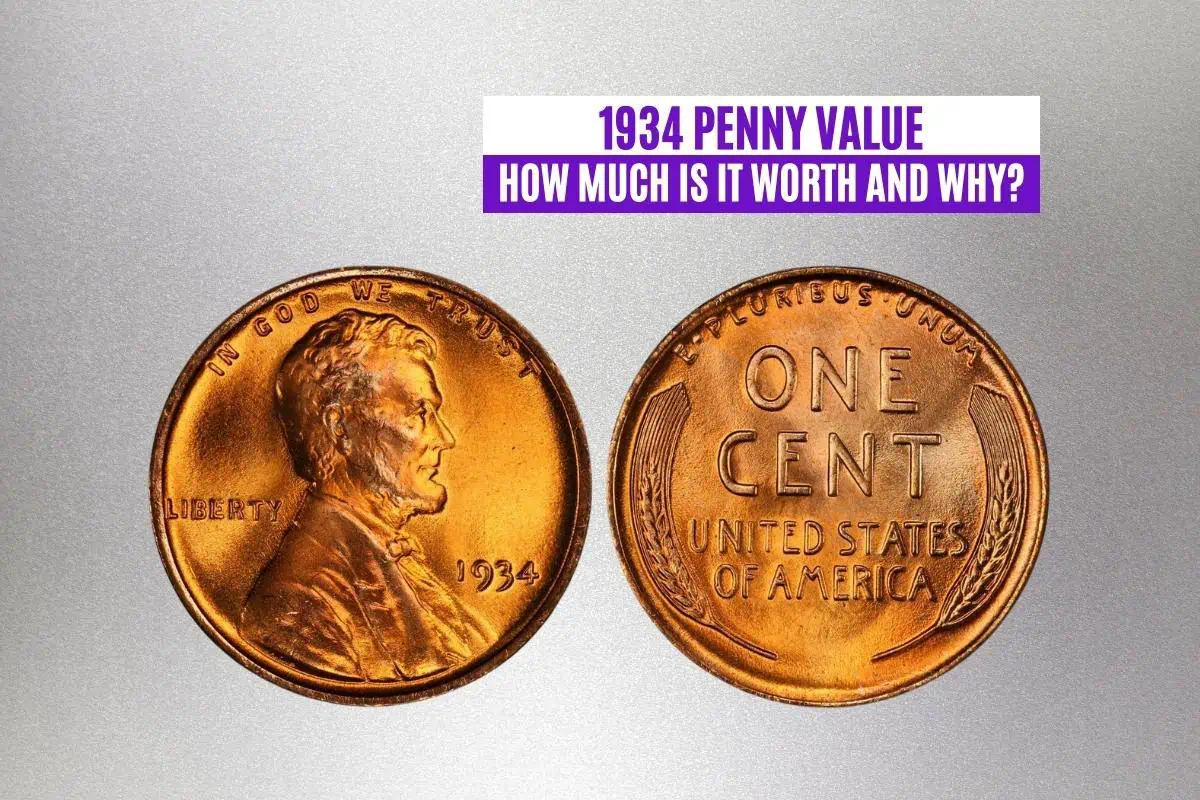The early 1930s were rough for most Americans, as the Great Depression was in full swing. This economic catastrophe even affected the U.S. Mint, with penny mintage numbers remaining below 25 million between 1931 and 1933.
But 1934 saw the first real boost in coin production since the start of the decade.
This penny cost guide will explore the 1934 Wheat penny value, helping you understand what qualities make this coin a valuable asset to your coin collection!
1934 Wheat Penny Value Chart
| Date & Mint | MS-63 | MS-65 | MS-67 |
| 1934-P Penny BN | $10 | $17 | $45 |
| 1934-P Penny RB | $12.5 | $28 | $70 |
| 1934-P Penny RD | $16 | $50 | $275 |
| 1934-D Penny BN | $21 | $28 | $150 |
| 1934-D Penny RB | $22.5 | $50 | $260 |
| 1934-D Penny RD | $30 | $90 | $4,800 |
1934 Wheat Penny: History
When discussing the 1934 penny history, it’s crucial to start with the coin’s most influential and impactful year: 1909.
1909 was the year that the Lincoln Wheat penny (also called the Wheat Reverse cent) was introduced! From this year forward (up until the current year), all pennies struck by the U.S. Mint have featured the now-iconic image of President Abraham Lincoln, face in profile looking toward the right.
Still, the 1934 Wheat penny isn’t only a continuation of the Lincoln Wheat cent’s legacy. It also marked an economic change.
Before 1934, most notably between 1931 and 1933, the U.S. Mint’s coin production output drastically decreased. This decrease was, at least in part, caused by the arrival of the Great Depression.
In fact, in 1933, when the Great Depression reached its lowest point. The U.S. Mint produced zero coins in some denominations, including nickels, dimes, and quarters. 1934 represented economic recovery, with U.S. Mint facilities finally increased and restarting major coin production.
For perspective, only about 20.56 million pennies were struck in 1933. But in 1934, the U.S. Mint produced more than 247 million! As such, the 1934 Wheat Reverse cent is valuable for several reasons, including historical significance.
1934 Wheat Penny: Design
The design for the 1934 Wheat penny was created by Victor David Brenner, whose initials (VDB) appear on the first batch of 1909 Lincoln Wheat pennies. This design lasted until 1959, when the coin’s reverse side was changed from wheat stalks to an image of the Lincoln Memorial.
Still, the obverse design created by Brenner remains, lasting more than a century and still present on Shield Pennies minted currently. As such, the front (obverse) side of the 1934 Wheat penny looks almost identical to the “heads” side of pennies struck today.
1934 Wheat Penny Obverse
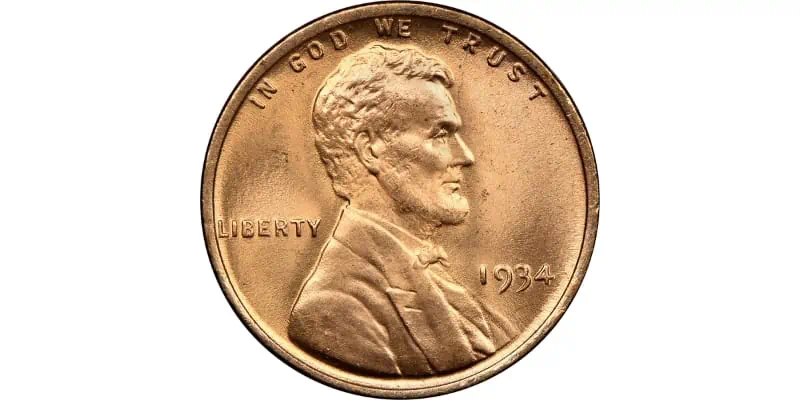
The obverse (front) side of the 1934 Wheat penny features the following design elements:
- In the center of the coin, the device (raised image) of Abraham Lincoln’s face in profile, looking right
- At the top of the coin, the motto “IN GOD WE TRUST” (above Lincoln’s head)
- On the left side of the coin, the legend “LIBERTY” (behind Lincoln’s shoulders)
- On the lower right side of the coin, the year date (1934)
- Beneath the year date, the mint mark (not present on pennies struck at the Philadelphia Mint)
1934 Wheat Penny Reverse
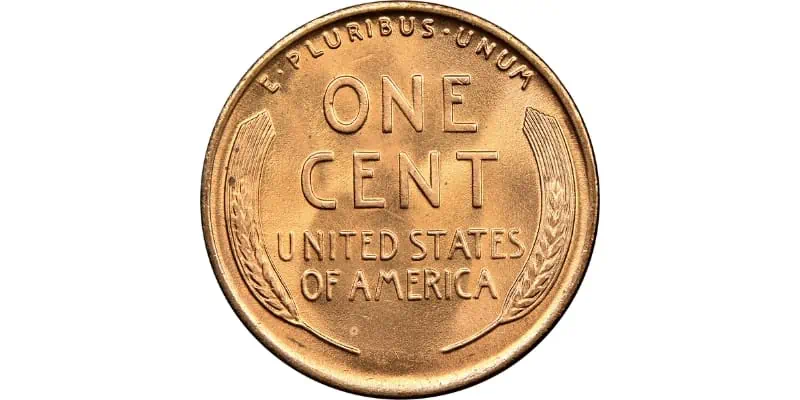
The reverse (back) side of the 1932 Wheat penny features the following design elements:
- On each side, two stalks of wheat encircling the issuing nation and denomination marks
- At the top of the coin, the motto “E PLURIBUS UNUM”
- Beneath the motto, the coin denomination “ONE CENT”
- Beneath the coin denomination, the issuing nation “UNITED STATES OF AMERICA”
1934 Wheat Penny: Features and Specifications
Three qualities differentiate 1934 Wheat Reverse pennies:
- The presence of a mint mark
- The coloration of the coin (red, red and brown, or brown)
- The coin’s condition (represented by a PCGS or NGC grade)
Apart from these qualities, all non-error 1934 Wheat pennies are essentially the same. For example, these one-cent coins:
- Are made of 95% copper (the remaining 5% is a mix of zinc and tin)
- Weigh about 0.11 ounces (3.11 grams)
- Are about 0.75 inches (19 millimeters) in diameter
- Have plain (smooth) edges
While these qualities are consistent among all pennies from 1934 (except those with errors), the differentiating factors (coin color, grade, mint marks) can significantly impact the value of the 1934 Wheat penny.
How Much Is a 1934 Wheat Penny Worth?
According to the NGC Price Guide, a 1934 No Mint Mark Lincoln Wheat penny (brown) in circulated condition is worth between $0.15 and $4.50. In uncirculated condition, it’s worth $6 to $45.
1934 Wheat Penny: Value Comparison
Even in poor condition, the 1934 Wheat Reverse penny is worth far more today than in 1934. This is partially because copper, the primary metal alloy present in 1934 pennies, has become far more valuable over time.
However, increased scarcity also plays a role. After all, about 90% of the pennies struck in 1934 are gone.
Some may have been melted down for their copper, but a significant portion likely degraded over time. While copper is a durable metal, it oxidizes when exposed to air and water. This oxidation can lead to rust, which eventually eats away at the metal, turning it into a fine powder.
Oxidation also impacts the value of this coin in several ways.
When the 1934 Wheat Reverse penny was newly minted, it had a rich reddish color. But as the copper in this coin began to oxidize, that color slowly transformed into a more muted brown. For this reason, finding bright red pennies from 1934 is challenging.
The red coloration associated with high-value 1934 Wheat pennies is also indicative of coin grade. It’s no accident that nearly all red (RD) 1934 Wheat pennies are in uncirculated condition. These coins wouldn’t have been able to retain their original coloration if they’d been heavily circulated!
So, when estimating the value of a 1934 Wheat penny, it’s crucial to consider coin color and grade. These factors are more significant than the coin’s mint mark (or lack thereof) in terms of valuation.
With this information in mind, let’s explore the 1934 Wheat penny’s value and discover which of these one-cent coins is worth the biggest bucks today.
1934 No Mint Mark Wheat Penny Value
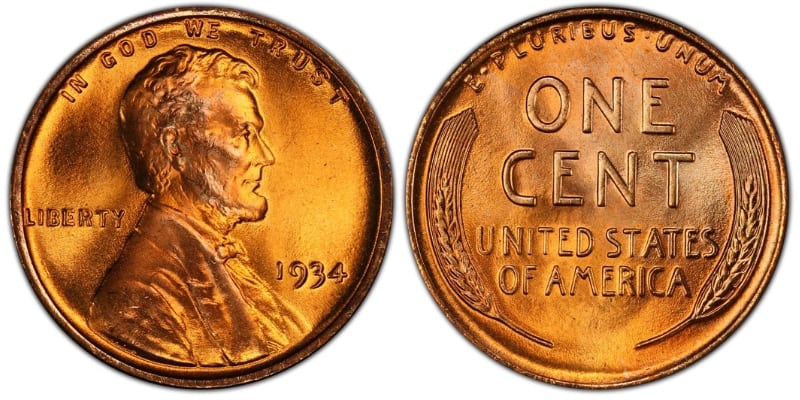
The 1934-P Wheat Reverse cent is often called the “No Mint Mark” penny, and for good reason!
This coin, struck at the Philadelphia Mint, doesn’t have a mint mark. In fact, the absence of a mint mark is one of the quickest and easiest ways to differentiate the 1934-P Wheat penny from the 1934-D Wheat penny.
Although the Philadelphia Mint struck over 219 million pennies in 1934, only about 22 million have survived to the current day. The vast majority of these pennies are heavily oxidized, giving them a brownish hue. Only about 20,000 falls into the “red and brown” and “red” color categories.
Consequently, brown (BN) 1934 No Mint Mark Wheat pennies are more common (and less valuable) than other RD or RB pennies. Still, they’re worth more than their listed denomination of $0.01.
Brown
A brown (BN) 1934 No Mint Mark Wheat penny in good condition (G-4) is worth about $0.15. That’s fifteen times its original value!
One in about uncirculated condition (AU-50) is worth about $2.75. The most valuable BN 1934 No Mint Mark pennies are in uncirculated condition (MS-60 grade or higher).
An MS-60 BN 1934 No Mint Mark Wheat penny is worth about $6, while one with a grade of MS-67 is worth about $45. The most valuable BN 1934-P Wheat cents are those graded at MS-67+. These coins have an estimated value of about $50.
Red and Brown
Red and brown (RB) 1934 Wheat pennies fall between “oxidized” and “like-new.” They show some signs of oxidation but are generally in uncirculated condition.
An MS-60 RB 1934 No Mint Mark Wheat penny is worth about $7. An MS-67 RB 1934-P Wheat Reverse cent is worth about $70. If you’re unsure whether your 1934 No Mint Mark Wheat penny is a BN or RB coin, you’ll want to submit it for professional grading.
Red
Red (RD) 1934 No Mint Mark Wheat pennies show minimal signs of oxidation. These coins are exceptionally rare and almost always in excellent condition. As you might expect, these qualities make them more valuable than BN 1934 No Mint Mark pennies.
An RD 1934 No Mint Mark Wheat cent with a grade of MS-67 is worth about $275. That’s a value increase of about 83% over BN pennies of the same grade!
Still, the most valuable (and highly coveted) RD 1934 No Mint Mark Wheat pennies are those with a grade of MS-68. These pennies can sell for upwards of $4,050.
1934-D Wheat Penny Value
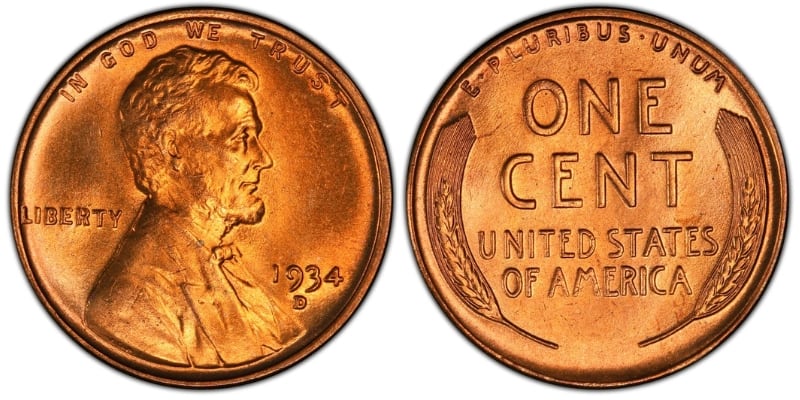
Apart from the Philadelphia Mint, the Denver Mint was the only U.S. Mint facility that struck Wheat Reverse cents in 1934.
The Denver Mint produced a little over 28 million pennies during that year. That’s only a small fraction of the Philadelphia Mint’s penny production numbers, making 1934-D Wheat pennies1934-D Wheat pennies rare from the start.
Fewer than 3 million of these one-cent coins are believed to exist today.
If you suspect that this increased rarity makes 1934-D Wheat Reverse cents more valuable than their No Mint Mark counterparts, you’re absolutely correct. But like the 1934 No Mint Mark Wheat penny, the 1934-D penny’s value is primarily based on coin color, and by extension, coin grade.
Brown
When found in good condition (G-4), a BN 1934-D Wheat penny is worth about $0.20. In about uncirculated condition (AU-50), this coin has an estimated value of $7.25.
In uncirculated condition, the BN 1934-D Wheat penny can be quite valuable. For example, an MS-60 BN 1934-D penny is worth about $16, while one with a grade of MS-67 is worth about $150.
So, let’s say you have two brown 1934 Wheat pennies, one with the “D” mint mark and one without a mint mark (a 1934-P penny). If both were MS-67 pieces, you’d be looking at a price difference of $105.
But the stark difference in value between the 1934-D and 1934 No Mint Mark penny only becomes more dramatic as you analyze the RB (red and brown) and RD (red) pennies.
Red and Brown
RB 1934-D Wheat pennies start at $18 (MS-60) and can sell for more than $260 (MS-67). Lower-grade uncirculated RB 1934 pennies can even sell for big bucks. For example, in 2003, an MS-63 RB 1934-D Wheat penny sold for $299.
Red
There’s no question that the most valuable of all 1934 Wheat pennies is the RD 1934-D penny. This one-cent coin might have only been worth $0.01 initially, but it can sell for thousands of dollars nowadays.
An MS-67 RD 1934-D Wheat penny is worth about $4,800, while one with a grade of MS-67+ can sell for more than $14,500!
1934 Wheat Penny: Rare Errors
Now that we’ve analyzed the 1934 penny cost, it’s time to discuss another facet of this brown-red coin: errors.
The modernization of the coin production process was well underway by the time the 1930s arrived, but that doesn’t mean that the U.S. Mint didn’t see occasional mistakes. These blunders created a unique class of coinage that can be quite valuable.
We’re talking about error coins.
Most error coins produced by U.S. Mint facilities never make it into circulation. The rare few that do immediately become highly desirable collector’s items, especially when those coins belong to low-production years.
If you’re looking for a one-of-a-kind 1934 Wheat Reverse cent to add to your coin collection, you’ll want to consider investing in an error coin. Two of the most significant errors to look for include:
- The planchet lamination error, and
- The off-center strike error
While the presence of an error doesn’t immediately make a 1934 Wheat penny exceptionally valuable, it can boost the base value of the coin. Still, when searching for 1934 Wheat penny error coins, it’s vital to also consider the coin’s grade and coloration before investing.
Still, let’s briefly take a closer look at these penny errors to find out how they impact price.
1934 Wheat Penny Planchet Lamination Error
Most coins (especially those produced within the last hundred years) are made of a combination of metal alloys. In most cases, these metal alloys are contaminant-free and properly combined, resulting in durable coins that can last several lifetimes.
But what happens when the metal planchets used to produce coins contain contaminants? In this case, you can end up with a coin that features lamination errors.
Lamination errors tend to exhibit themselves are significant flaking or cracking along a coin’s surface. But unlike die crack errors, these cracks aren’t raised. Instead, they resemble a small chasm (die cracks appear as an elevated line).
A 1934 Wheat Reverse cent with a lamination error can sell for between $1 and $100, depending on the coin’s condition and the error’s severity.
1934 Wheat Penny Off-Center Strike Error
Metal planchets (also called blanks) become coins after they’re pressed between coin dies. But when the planchets aren’t perfectly centered between these coin dies, the design impressed into them can end up off-center.
It’s easy to identify off-center strike error coins, as they tend to exhibit some blank, even surfaces (the original coin planchet) and a partially missing coin design. The most valuable of these error coins are those with significant off-center striking.
For example, a 10% off-center strike coin is generally worth far less than a 90% off-center strike coin. An off-center strike 1934 Wheat penny is worth up to $300, with coin condition and off-center strike percentage being the primary factors impacting price.
Frequently Asked Questions
Would you like to learn more about the 1934 Wheat penny? Don’t hesitate to check out the frequently asked questions below!
How Many 1934 Wheat Pennies Exist Today?
According to PCGS coin survival estimates, roughly 24.886 million 1934 Wheat pennies exist today. That’s about 10% of all the Wheat Reverse pennies struck in 1934, making this one-cent coin increasingly rare and valuable.
What’s the Auction Record for the 1934 Wheat Penny?
The 1934 Wheat Reverse penny auction record was set in September 2018. An MS-67+ RD 1934-D Lincoln Wheat penny sold at auction for $20,350. No other penny has sold at auction for such a staggeringly high price!
Are There Any Proof-Strike 1934 Wheat Pennies?
No, there are no proof-strike 1934 Wheat pennies. The U.S. Mint didn’t produce any proof-strike pennies between 1917 and 1935.
1934 Wheat Penny Value: Final Thoughts
The value of a 1934 penny varies depending on its mint mark, coloration, and coin grade. The most valuable 1934 Wheat pennies are red and in uncirculated condition (MS-60 grade or higher).
Although the 1934 Wheat penny value varies significantly (between $0.15 and $14,500+), collectors should keep an eye out for this coin across all grades. After all, the increasing scarcity of this penny ensures that the 1934 penny value will only increase with time.
Learn more about high-value coins by checking out these related articles now!

